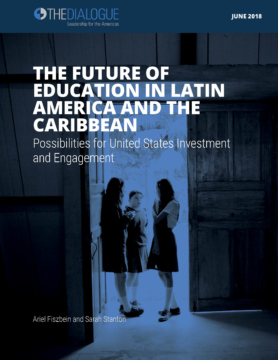“Spain is no longer Latin America’s gateway to Europe,” said the editorial staff of Política Exterior at the Inter-American Dialogue on May 5. Áurea Molto, assistant editor of the Spanish foreign affairs monthly periodical and former visiting fellow at the Dialogue, led the discussion of Spain-Latin American relations. Molto explained how the relationship is changing due to the growing power and influence of Latin America. Spain and Latin America are most strongly tied through their exchange of trade and investment, people, and narcotics, and added that Ibero-American integration must be rethought. Latin America can no longer be considered one bloc, she said, rather it must be understood as a region comprised of many diverse countries.
She was joined by the former ambassador of Spain to the United States, Jaime Ojeda, and Política Exterior editor Darío Valcárcel.
Spain’s failure to adjust its policies to differences in the region has dimmed hopes of greater Ibero-American integration, Molto said. In the last several decades, Latin American alliances and sub-regional blocs have formed while certain countries, like Brazil, are taking a lead role on the international stage. Changes in economic policies, social policies, and the role of democratic institutions have further differentiated the countries of Latin America. At the same time, the arrival of new external influences including China, Russia, India, and Iran, has further diversified the playing field.
Still, Spain, along with the European Union, is the largest contributor of development aid to Latin America. European foreign investment in the form of telecommunications, energy, and construction has grown and is integral to Latin American development. Spain alone remains the second largest external investor in the region. These ties have added a new political dimension to the Ibero-American relationship.
Unfortunately, while Spain has worked extensively to develop Latin American economic blocs, such as Mercosur, success has been modest at best.
Turning to domestic issues, the editorial staff of Política Exterior pointed out that historic and linguistic ties, relatively lax immigration laws, and the access it affords to the EU make Spain an obvious destination for Latin American migrants. Ten percent of Spain’s population is comprised of immigrants and, except for Romania and Morocco, nearly all come from Latin America. That Spain will allow Latin American immigrants to cast their vote in 2011 could mean changes for the European Union. “The Latin American vote in the EU is in Spain,” Molto said.
A significant challenge to Spanish-Latin American bilateral relations is the illicit drug trade. Spain is Europe’s biggest entry point for illicit narcotics, although many now come through western Africa rather than directly through Latin America. This influx of drugs has encouraged Europe to rethink its drug policy, a process underway throughout the Americas as well. The biggest threat that accompanies the drugs coming into port is organized crime. Gangs from Central America now have a vested interest in Europe where they did not before, and Barcelona and Madrid especially have felt the effects of increased crime. “There’s a fundamental necessity to create a common drug agenda between Spain, the US, and Latin America,” Molto said.






















